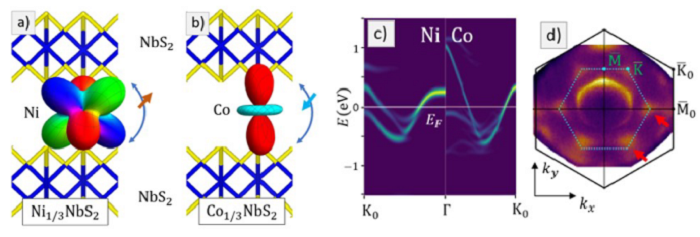This website uses cookies to ensure a better user experience.
To get more information, please read our Cookie Statement.
Intercalation-induced states at the Fermi level and the coupling of intercalated magnetic ions to conducting layers in Ni1/3NbS2
Our colleagues Yuki Utsumi Boucher, Petar Popčević, Ivo Batistić, and Eduard Tutiš, in collaboration with scientists from AGH University of Krakow, Solaris synchrotron, Jagiellonian University, University of Zagreb, Institute of Nuclear Physics PN, and TU Wien, revealed the electronic structure of nickel intercalated 2H-NbS2. The collaboration between experiment and theory proved to be crucial in providing insight into the special role of magnetic Ni ions in the electronic structure. The measured spectra and theoretical analysis indicate zero algebraic sum of hybridization integrals of relevant Ni orbitals and the conducting planes of the host material. The work received “Editors’ Suggestion” from Physical Review B.
Intercalation-induced states at the Fermi level and the coupling of intercalated magnetic ions to conducting layers in Ni1/3NbS2
Yuki Utsumi Boucher, Izabela Biało, Mateusz A. Gala, Wojciech Tabiś, Marcin Rosmus, Natalia Olszowska, Jacek J. Kolodziej, Bruno Gudac, Mario Novak, Naveen Kumar Chogondahalli Muniraju, Ivo Batistić, Neven Barišić, Petar Popčević, Eduard Tutiš
Physical Review B 109, 085135 (2024),
DOI: 10.1103/PhysRevB.109.085135
Two-dimensional magnetic materials are of great interest from the fundamental point of view and for applications. In particular, the magnetic sublayers, introduced by intercalation into the van der Waals gaps of the host transition metal dichalcogenides, are known to produce various magnetic states depending on the choice of magnetic intercalates, with some being tunable by pressure and doping. The magnetic intercalates strongly modify the electronic coupling between layers of the host compound. Understanding the origins of such variability, starting from the underlying electronic structure, is a significant challenge. By using angle-resolved photoelectron spectroscopy (ARPES) with various photon energies and ab initio electronic structure calculations, the study revealed the electronic structure of Ni1/3NbS2. By comparison with their previous study of Co1/3NbS2, strong yet unusual hybridized states between NbS2 conduction bands and the Ni 3d orbitals are discovered near the Fermi level. In the particular case of Ni1/3NbS2, the hybridization between metallic NbS2 layers is almost entirely suppressed in the central part of the Brillouin zone. Simultaneously, it gets very pronounced towards the zone edges. The study proves that the type of intercalates and their magnetic order strongly affect the electronic structure. The result also shows that the magnetic fluctuations at bridging sites are prone to produce strong electron correlation effects at the Fermi level, inaccessible to density functional theory (DFT+U) calculations.

Figure 1. Schematic image of strong spin-selective hybridization between NbS2 layers provided by intercalated magnetic ions (Ni, Co). The symmetries of dominant bridging orbitals in (a) Ni1/3NbS2 and (b) Co1/3NbS2. (c) The calculated band structures that show the type of magnetic ordering strongly affect the electronic structure. (d) The Fermi surface observed by ARPES. The magnetic fluctuations at bridging sites are prone to produce a strong electron correlation effect at the Fermi level (shallow electron pockets indicated by red arrows), which is inaccessible by DFT+U calculations.




